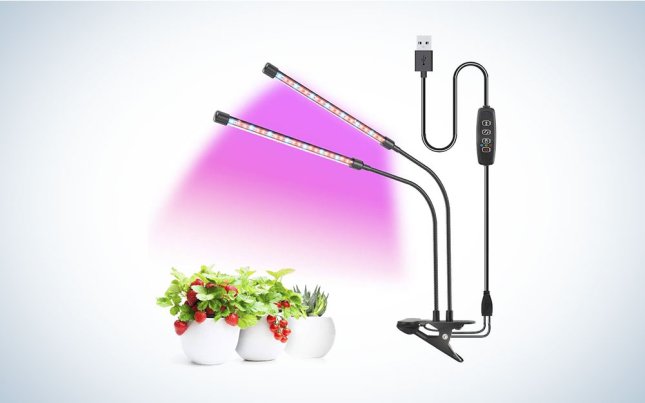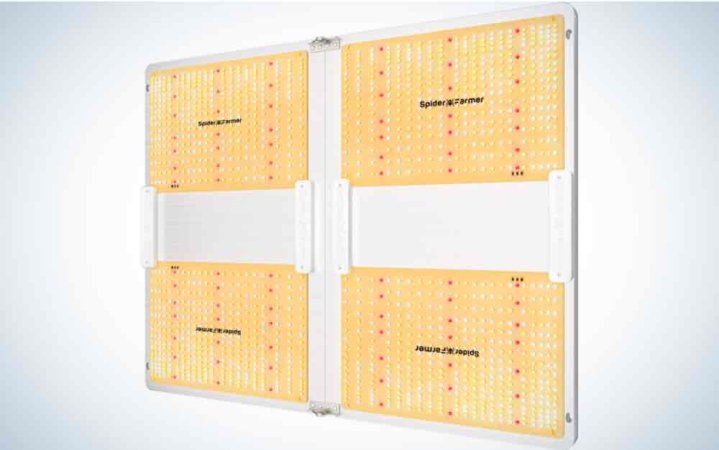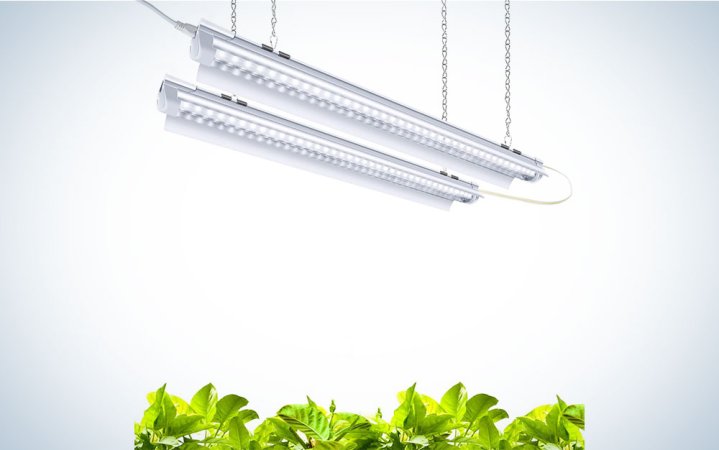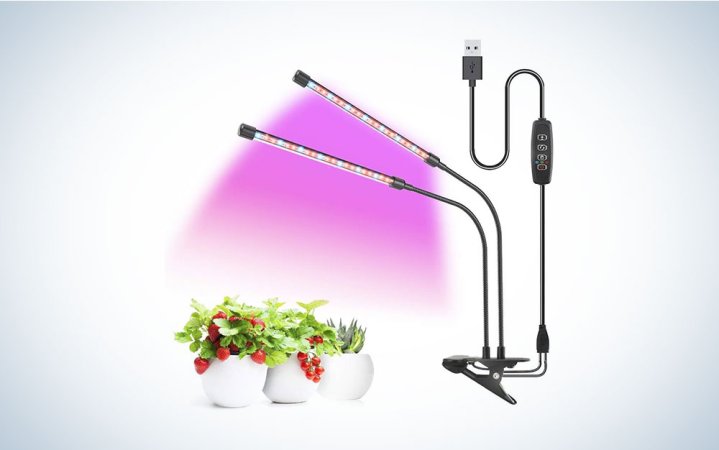We may earn revenue from the products available on this page and participate in affiliate programs. Learn more ›
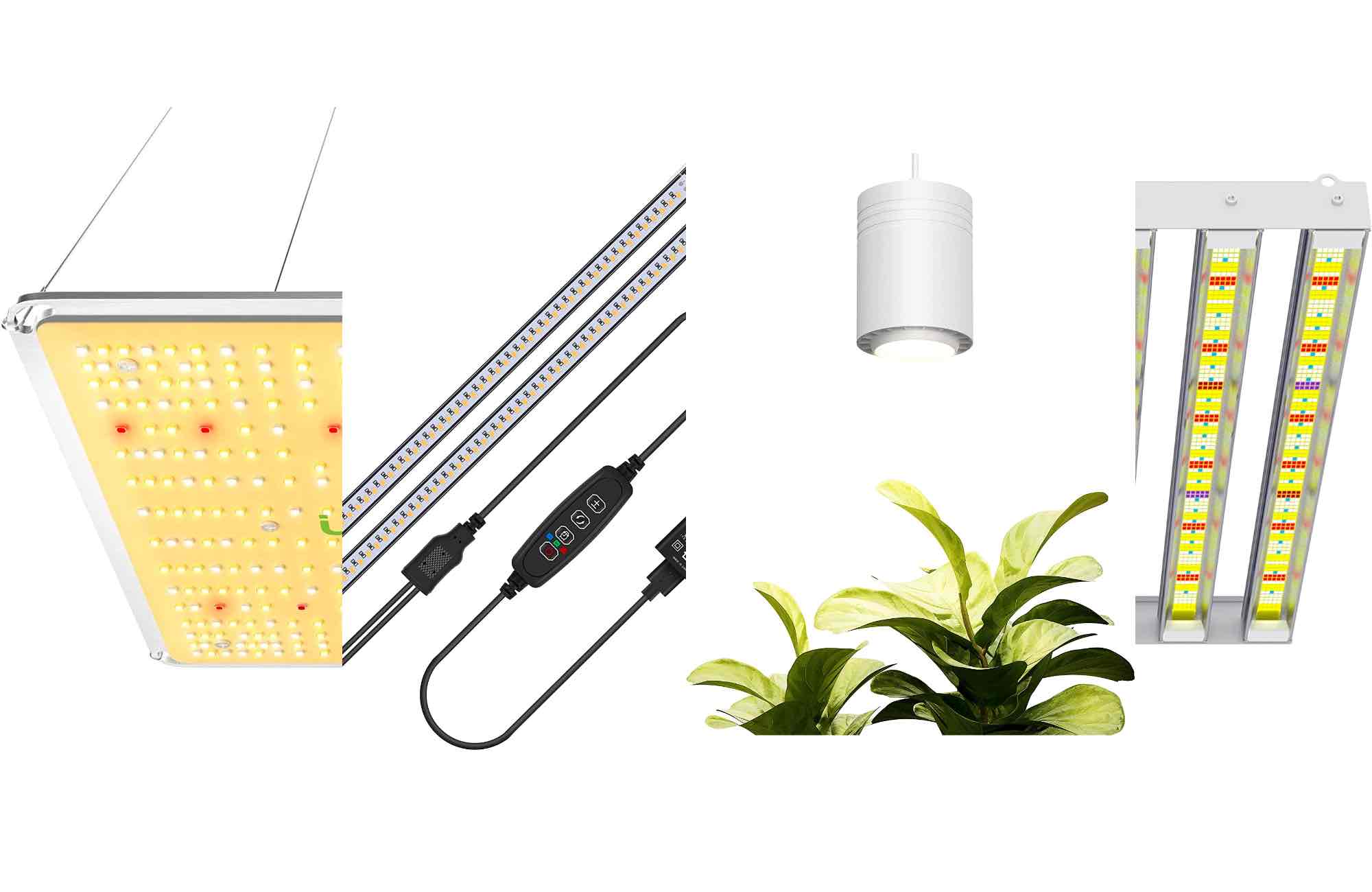
Until scientists invent convenient mini Suns that we can contain inside our homes, our plants must rely on artificial daylight like that emitted by LED grow lights. Fortunately, those illumination sources have come a long way in terms of efficiency and efficacy. LED technology has improved everything from TVs to your smartphone, but it can also help your plants. Whether you’re trying to baby your indoor plants, nurture some seedlings that will eventually go out into the garden, or just please an outdoor plant that needs to spend some time inside, these LED arrays can pump out the photons plants crave. But you can’t just go shining an LED flashlight at your precious plants. You must pick the right power, color, and size to make your indoor garden thrive. That can be tricky, but these picks can provide the perfect illumination no matter what your flora looks like. The best LED grow lights will allow you to become an indoor botanist without much effort.
- Best overall: Soltech Solutions Grove LED Grow Light
- Best commercial: Spider Farmer SF7000 LED Grow Light
- Best for vegetables: Monios-L LED Grow Lights
- Best for succulents: Small White Aspect Luxury LED Grow Light
- Best budget: Sun YOBA LED Grow Lights
How we chose the best LED grow lights
The PopSci writers and editors truly love plants, but we don’t all live where our favorite flora friends thrive. That means serious indoor growing sessions. I personally keep an extensive outdoor garden in New York’s native climate but annually start vegetable seedlings inside to maximize the growing season.
The best LED grow lights: Reviews & Recommendations
For this guide, we considered a wide swath of different lights that can apply to almost any grower in nearly any space. We considered important variables, including power usage, size, and spectrum. These lights can consume a ton of energy, even with LEDs, so we centered our search around efficient models that cover a lot of uses.
Best overall: Soltech Solutions Grove LED Grow Light
Best full-spectrum
Expert panel
Pros
- Stylish
- Dimmable
- Touch power
Cons
- Slightly expensive
Why it made the cut: This light can handle most plant needs and places thanks to its flexibility.
Specs
- Input power: 11 watts
- LEDs: N/A
- Color: 3,000 Kelvin
You may not need a huge light array now, but you might want to grow your indoor garden down the road. If that’s the case, you want a system that’s easy to expand while giving you the same color, quality, and amount of light. This is the most beautiful, well-designed grow light you’ll find.
The Soltech Solutions Grove LED grow light clocks in at 11 watts of consumption. It provides an ideal mix of warm and sun-colored light to foster indoor growth across a wide variety of plants.
This tube-shaped illuminator lasts for 50,000 hours, so it will keep pumping out photons for many seasons. Because the LEDs are high quality, they’ll last longer, but they’re also more efficient, which leads to less overall electricity usage down the road, even if you’re trying to get those tomatoes just right.
Best commercial: Spider Farmer SF7000 LED Grow Light
Pros
- Powerful
- Lots of coverage
- Daisy-chainable
Cons
- Consumes lots of power
Why it made the cut: More than 1,700 lamps pump out ample light for large growing areas, and its fine-grain control makes it friendly to new commercial growers.
Specs
- Input power: 650 watts
- LEDs: 1,700
- Color: Full-spectrum
If you have a big growing area or particularly light-hungry plants, you need a light panel covering a wide area. This one from Spider Farmer provides sun-like light over an area of five by five feet. Moreover, you can daisy-chain up to 60 additional lamps together for full greenhouse coverage.
It has over 1,700 individual LEDs onboard, split between sun-simulating white and infrared. You can control all of the SF7000’s lamps simultaneously, so you can dial in the exact power level you need rather than adjusting certain lights individually. The heat doesn’t negatively impact the light panel because of a six-inch inline fan, which will make some—but not too much—noise. If you use this light panel outside, this won’t be an issue at all.
This ease of use, combined with the SF7000’s power, makes the grow light ideal for those who want to dip their toe into commercial growing while still being suitable for seasoned pros.
Best for vegetables: Monios-L LED Grow Lights
Pros
- No humming
- Long cords
- Can connect multiple lights
Cons
- Isn’t water resistant
Why it made the cut: This adjustable fixture can accommodate a variety of plants and vary its output to meet specific needs.
Specs
- Input power: 48 watts
- LEDs: N/A
- Color: 5,000 Kelvin
Every indoor gardening space looks different. Maybe you have tons of room for serious fixtures and long tables. Or, maybe you’re trying to make your plants work in a closet. Our pick for the best LED grow lights for vegetables from Monios-L, can help make it happen.
The 5,000 Kelvin lights should last roughly 30,000 hours of operation and can sit anywhere from one to five feet away from your plants. Because vegetables, like tomatoes, require different levels and types of light, the flexibility really makes the difference here, even though it will add some cash to the price.
Best for succulents: Small White Aspect Luxury LED Grow Light
Best for succulents
Point of light
Pros
- 90,000-hour life
- Attractive
- 15-foot cord
- Affordable
Cons
- Small coverage area
Why it made the cut: You don’t want a massive array just to take care of a single plant, so check out one of the best grow lights for succulents. This attractive option is effective without sticking out like a sore thumb.
Specs
- Input power: 40 watts
- LEDs: N/A
- Lumens: 3,000 Kelvin
If you’re only keeping a small succulent on your desk, it really doesn’t need much in the way of extra light. That goes for other similarly small but pleasant-to-have-around plants. This LED from Aspect sits at the end of an attractive 15-foot, fabric-wrapped cord. It puts out enough light coverage to nurture one or maybe a few small plants or seedlings without spilling photons everywhere.
It has a built-in timer, so it can turn on and off even when you’re not paying attention to it. So, if you’re away from the office for a while, your plants can still get a little time in the sun. The aluminum enclosure looks like something out of a design magazine.
The bulb isn’t very powerful, but it has a suggested lifespan of around 90,000 hours, which means it can last well over a decade with regular use before replacing it.
Best value: Sun YOBA LED Grow Lights
Best value
Flexible solution
Pros
- Easy to install anywhere
- Low power consumption
- Full-spectrum
Cons
- Low power output
- Small coverage area
Why we picked it: This cheap lamp is flexible and super-easy to install for gardeners who need just a little bit of light.
Specs
- Input power: 40 watts
- LEDs: 40
- Color: 2,000 Kelvin
You don’t always need a full-on sun replacement inside your home to help your plants grow. These simple strips from HitLights have 40 LEDs and are easy to install pretty much anywhere. The assembly process requires a table or post to clip it to.
Because of their small size, the lamp consumes an extremely small amount of electricity while still putting out enough shine to sustain small and even medium indoor plants. The dimming function offers nine brightness levels, and the built-in timer can turn the lights on and off on three-, nine-, or 12-hour cycles. That way, you don’t have to remember to turn the lights on and off yourself and risk giving your plants too much or too little illumination.
Because the lights are compact, they’re not good for covering large areas or sustaining light-hungry plants requiring heavy sun sessions. But, they draw power from USB, so it’s a simple budget solution to keep on a counter for herb gardens and nurture a seedling that might otherwise suffer under the drab fluorescents of an office.
What to consider when buying the best LED grow lights
While just about every plant loves light, they don’t all have the same taste. Here are some things to consider when buying an LED grow light:
Power consumption
Even though LEDs are much more efficient than their older counterparts, they still require constant energy to run. And leaving them on all the time—especially if you’re running a lot of them—can really start to ramp up the ecological impact and your electric bill.
Older bulbs used to measure power in watts, but LEDs don’t quite work like that. Input power on an LED suggests how much power it’ll use but not necessarily how bright it will be. High-efficiency LEDs can put out a lot of light with a few lamps, while other arrays use a higher number of smaller lamps.
Your needs are specific to your plants, but don’t go buying an LED light array just because it has a high wattage rating. Look for an equivalent wattage number or other methods of measurement.
Spectrum coverage
Full-spectrum lights can mean different things depending on the model. True full-spectrum lights include infrared modules that emit waves you can’t technically see. Different light wavelengths often serve different parts of the growing process, so you’ll want to match up the spectrum performance with the plants you’re trying to grow. If your plants aren’t picky, most “full spectrum” lights should do a fine job. But it’s worth researching your specific plants to make sure the light you’re buying offers what they need.
Dimmability
Not all grow lights are dimmable. Some have either an on or off setting, and not much else. Other LED grow lights can offer 10 or even more different levels of illumination, so you’re not always blasting them on full power.
Self-timers
Plants don’t need light 24 hours per day, so you’ll want to turn lights on and off as needed. Some lights have built-in timers that allow you to program in a custom schedule. That absolves you from having to remember to hit the switch, which can have a profound effect on plants, especially if you’re trying to start outdoor plants inside.
FAQs
Picture plants in nature. They’re not always in the sun. The same goes for artificial lights. Leave lights on too long and it can affect how your plants bloom due to the light’s effect on metabolism. Lights also emit heat (yes, even LEDs), which can dry the plants out or even burn them.
It can vary depending on what kind of lights you buy and what kinds of plants you’re growing, but the general rule of thumb is that you want 25-50 watts (equivalent) of light per square foot. Again, that’s only a starting point, so you’ll want to get more specific with your research about your plants if you’re trying to get serious about a grow room that big.
While this article addresses LED solutions, you’ll also find many growers still rely on HPS, or high-pressure sodium, lights. LED is more power-efficient and typically offers better spectral coverage. HPS, however, can be cheaper to get started with and the fixtures are often easier to repair and replace parts in.
This depends on their size and power level. You can spend less than $20 or well over $300 based on your needs. Commerical-friendly models will cost more than those meant for home use.
Final thoughts on the best LED grow lights
- Best overall: Soltech Solutions Grove LED Grow Light
- Best commercial: Spider Farmer SF7000 LED Grow Light
- Best for vegetables: Monios-L LED Grow Lights
- Best for succulents: Small White Aspect Luxury LED Grow Light
- Best budget: Sun YOBA LED Grow Lights
If your plants need a little top-up when it comes to sunshine, the best LED grow lights can provide just that in an affordable, efficient way. If you’re getting serious about growing, you’ll want to ensure you get the right kind of light for your plants, but there’s almost certainly an LED option out there that can give you exactly what you need.


